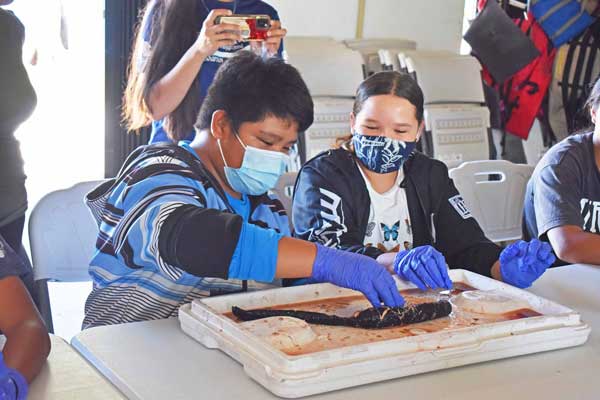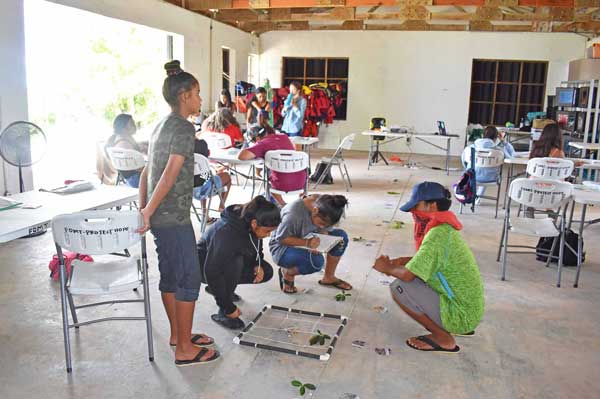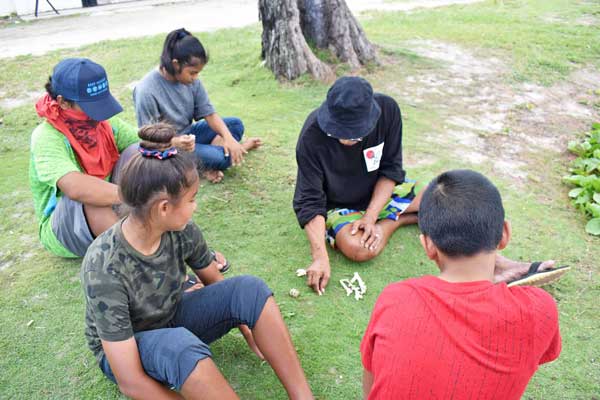Project HOPE: Healthy Oceans & People Empowerment
Cultivating the hope of the future, for the CNMI’s oceans

Project HOPE students get to be hands-on during their class on Sea Urchin Dissecting by Dave Benavente. Last Fall 2020, students from Tanapag Middle School and Dandan Middle School piloted the program, the goal of which is to cultivate 30 new indigenous ocean/marine scientists by 2030. (Friends of the Mariana Trench)
Seventeen students from Tanapag Middle School and Dandan Middle School had just successfully completed, this Fall semester, their ocean-science journey with Project HOPE (Healthy Oceans & People Empowerment), where they learned about the ocean and its marine life, the policies that protect them, and really, just how important a role the ocean plays for the island’s present and future generations.
Project HOPE is a no-cost ocean science program created by Friends of the Mariana Trench, under a grant from the Administration of Native Americans, and their goal—to cultivate 30 new indigenous ocean/marine scientists by 2030.
Saipan Tribune sat down with Joe Villacrusis, FOMT project coordinator, to learn more about Project HOPE, and go deep into this very significant educational undertaking.
“We would like to develop an interest in these children to become ocean stewards and/or become ocean scientists. We also want them to know and understand the culture surrounding our oceans and the traditional practices from our ocean elders so that they can make the connection with that and science,” Villacrusis shared.
“This will greatly benefit the community because we are nurturing and developing these young minds to become more aware of how important our ocean is to not just for our culture and community, but also for many generations to come,” he added.
Through Project HOPE’s experiential learning, young minds get molded into becoming more aware and protecting of the environment, particularly of the ocean.
Right now, for 2021, they are rounding up new 6th graders to add to those who already pre-registered from the Fall. “Recruiting starts now through approximately Feb. 14. We are going to hold learning sessions from mid to late February lasting through early June.”
Cultivating new marine scientists
FOMT’s strategic focus, from 2019 up until 2024, is on creating educational pathways that support the cultivation of 30 new indigenous ocean/marine scientists by 2030.
“The FOMT founding members always envisioned that we could help support education pathways to ocean and marine science degrees for our local citizens. We also saw the opportunity for citizen scientists to help with research projects for our community.”
In 2017, FOMT held its first Open ROV (remote-operated vehicles) robotics building workshops—two intensive trainer’s training workshops, where those trained were taught to teach students on how to construct, maintain, and operate underwater remote operated vehicles, to formal and informal researchers, citizen scientists, junior high, high school and college students.
“Project HOPE is our second big adventure in pursuing our goals to help with increasing ocean and marine science education in the CNMI,” Villacrusis said.
For two years, from 2018 to 2019, FOMT brainstormed with members of the community, to create a structure that would achieve the goal of cultivating new marine scientists on island. They looked at enrollment at the Northern Marianas College to see how many students were participating in the Natural Resources Management Program and tried to determine how many of them are actually interested in marine science.

Johnston Applied Marine Sciences’ Kelsey McClellan, who works on coral reef restoration via the Saipan Coral Nursery Project, engages the Project HOPE students through a Coral Reef Mapping activity. (Friends of the Mariana Trench)
FOMT’s research on how to increase the number of students seeking marine science degrees led them to examining the current ACT Aspire test scores for middle school students, and then discussing the importance of 6th grader-aptitude with PSS teachers and curriculum professionals.
Villacrusis added that, inspired by the desire to improve sixth grader’s ACT aspire test scores, Project HOPE got designed to use experiential learning to help CNMI students understand experimental results, inferences, models and data.
From there, they reached out to some of the island’s ocean elders to ask for guidance on how to blend traditional practices with the STEM principle learning taught in most formal education environments, as well as inquired with marine science professionals on how to best structure their approach.
This resulted to a multi-tiered approach, Project HOPE being just the first step.
“There are three more projects we are developing that work together with Project HOPE, which will target other age groups—3rd, 9th, and 12th grades. We are also being inclusive and sensitive to other projects already underway so that our efforts will enhance work that is already in progress.”
What students can learn
“HOPE is also an ocean conservation program that allows sixth graders, college students, and experienced ocean experts to join forces in protecting their home. Project HOPE is the sun of FOMT’s universe and we are building everything else around it.”
Last Fall 2020 semester, with active involvement from five Ocean Elders and seven NMC ENRO Club members, Project HOPE students learned about the following: Introduction to Oceans, Currents/Tides, Water Cycle, Climate Change, Coral Reef Life, Coral Bleaching, Marine Protected Areas, The Marianas Trench, Bays & Estuaries, Upwelling Zones, Open Ocean, Mangrove Trees, swimming, rope tying, and even dissecting sea urchins.
“The topics below were chosen because it was aligned with some of the conceptual and aptitude questions in science from the ACT Aspire Assessment given to students in the CNMI Public School System especially at the middle school level,” Villacrusis explained.
“… So not only are we providing these children with knowledge about the ocean, we are also teaching them how to apply this knowledge to get better scores in their assessment in science.”
For this year, 2021, sessions will be similar to those held in the Fall, but with improvements based on what FOMT learned from Project HOPE’s pilot session.
The semester will wrap up with an Ocean Camp mid to late June, based on the last days of the Public School System’s school calendar.

Ocean elder Tony Piailug sharing his traditional knowledge about coral reef. Aside from coral reefs, the students, through Project HOPE, were able to learn about currents and tides, water cycle, climate change, marine protected areas, bays and estuaries, upwelling zones, mangrove trees, the Marianas Trench, and the open ocean. (Friends of the Mariana Trench)
Hope for the future
Project HOPE began in late 2019, with the awarding of the ANA grant. The ANA grant is funded through September 2022, but as early as now, strategies are already being built by FOMT to continue the program via alternate resources once the ANA grant ends.
Aside from children learning about the ocean, its marine life, and how to protect them, Project HOPE can also open opportunities for the college to offer more science programs, and subsequently, open more jobs and attract different scientists from around the world to study our surrounding ocean, especially the Marianas Trench.
“The first thing we want the community to know is to get the facts about the ocean, the marine life it supports, and how it serves humans as a whole. Once they understand how important the ocean is to us, they will better understand why it is critical to protect it. Human behavior has the greatest impact on the ocean,” Villacrusis stressed.
“How we live our lives can directly and indirectly affect the ocean. So every little action such as picking up after ourselves and practicing a more sustainable lifestyle can add up if everyone does their part and takes responsibility for our environment.”
To register for, or learn more about Project HOPE, as well as other programs of the Friends of the Mariana Trench, call (670) 483-FOMT (3668), or email info@friendsmarianatrench.org.























